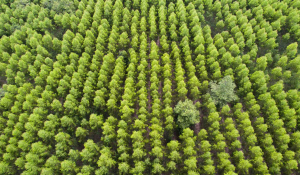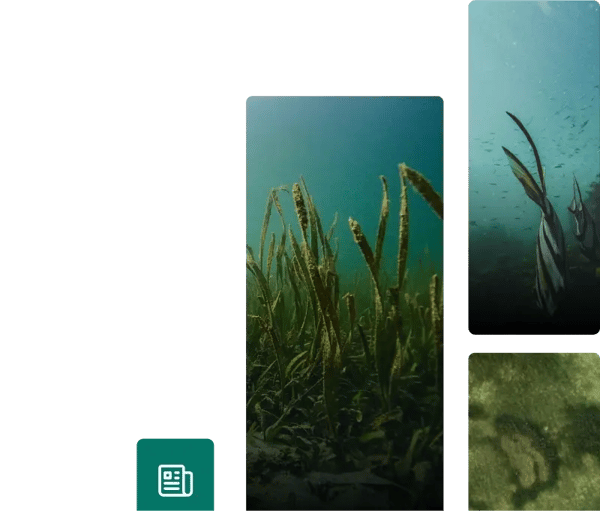Carbon Glossary: the most important definitions
Here are all definitions you will need to become a carbon expert yourself.
Additionality (Environmental):
According to GoldStandard, additionality is a core provision for environmental integrity in carbon markets. The demonstration and assessment of additionality ensure that emission reductions generated by activity would not be achieved in the absence of revenue from the sale of carbon credits.
Afforestation:
Plantation of new forests on lands that never hosted trees in the past, i.e. creating new forests.
Anthropogenic:
Resulting from human activities, such as anthropogenic emissions or removals.
Avoidance Projects:
Projects that prevent carbon emissions that would have been released into the atmosphere if business-as-usual occurred - the baseline scenario. Current emissions are reduced by targeting carbon-intensive activities and creating improved alternatives. Essentially, these projects help avoid additional carbon being released. Project examples include forest conservation, renewable energy, fuel switch, and household devices.
Blue carbon:
Water-based carbon solutions in coastal and marine ecosystems. Such as; mangroves, tidal marshes, and sea grasses, which absorb a high amount of carbon dioxide in both the plants and sediments.
Carbon Credits (on the Voluntary Carbon Market):
Credits emitted from a project after being certified and verified: 1 carbon credit is equivalent to the avoidance or absorption of 1 tCO2e (tonne of carbon dioxide equivalent).
Carbon Footprint:
A carbon footprint is the amount of greenhouse gasses emitted by an organization through all its activities: one’s environmental impact in terms of carbon emissions.
Carbon Neutrality:
Worldwide equilibrium between anthropogenic emissions and anthropogenic absorption. As such, an organization, product, or service cannot be carbon neutral by itself but can contribute to achieving global carbon neutrality. The objective of carbon neutrality is twofold: to reduce the total amount of emissions and increase absorption capacity.
Carbon Offsetting:
The term carbon offsetting refers to compensating residual greenhouse gas emissions through projects that absorb or avoid carbon dioxide. “Residual” is a key term as an organization must offset only after having reduced its emissions.
Carbon Sinks:
A forest, ocean, land, or soil that absorbs more carbon dioxide than it emits.
Certification of Carbon Credits:
Voluntary emission reduction (VER) is carbon credits issued by a verified project. Standards such as VCS or the Gold Standard follow a rigorous methodology to certify the projects and their carbon credits. For a project to be certified, it has to be real (proven to have taken place), measurable (all emission reductions/removals have to be quantifiable using recognized measurement tools, with uncertainty and leakage taken into account, against a credible emission baseline), permanent (in the case of a risk of reversibility, adequate safeguards need to be implemented), additional (see above), independently verified (by an independent qualified third party) and unique (no more than one carbon credit can be associated with a single emission reduction or removal as one metric ton of carbon dioxide equivalent (CO2e)). Source: SBTI.
Climate Change:
A change in climate that is attributed directly or indirectly to human activity alters the composition of the global atmosphere and which is in addition to natural climate variability observed over comparable time periods. Source: UNFCCC.
Climate Contribution:
Supporting an emission reduction project in the Voluntary Carbon Market that not only captures or avoids greenhouse gas emissions but also contributes to the United Nations Sustainable Development Goals. Climate contribution is different from carbon offsetting as there is no definite point of arrival: the more contribution and emission reduction, the more benefits for the planet. Contributing to a project beyond the carbon impact, looking at the impact on nature, community, people, plus the carbon. The co-benefits of the project are key.
Co-benefits:
Additional positive externalities of climate contribution projects, which target the United Nations Sustainable Development Goals (UN SDGs).
CO2e:
Carbon dioxide equivalent. A metric measure is used to put all the greenhouse gasses on the same scale on the basis of their GBW (global-warming potential).
Decarbonization:
The process by which countries, individuals, or other entities aim to achieve zero fossil carbon [usage]. Typically refers to a reduction of the carbon emissions associated with electricity, industry, and transport. Source: IPCC.
Double-counting:
A term describing the situation in which two parties claim the same carbon removals or emission reductions.
Energy Mix:
Different sources of energy are used by a country or an organization. Fossil fuels accounted for more than 60% of the world’s energy mix or ‘Global primary energy consumption in 2019. Source: Our World in Data.
Fossil Fuels:
Fossils such as coal, oil, and gas, are the result of millions of years of decomposition of organic matter living. These fuels highly emit greenhouse gas when consumed.
GHG Protocol:
GHG Protocol establishes comprehensive global standardized frameworks to measure and manage greenhouse gas (GHG) emissions from private and public sector operations, value chains, and mitigation action. It is the most used method on an international scale to measure and reduce greenhouse gas emissions. Source: GHG Protocol.
Learn more
Greenhouse Gas:
Gas accelerates the greenhouse effect causing Earth’s warming by trapping heat in the atmosphere. The 7 main greenhouse gasses are carbon dioxide, methane, nitrous oxide, and 4 fluorinated gasses.
Greenwashing:
A behavior or some activities that make people believe that a company is doing more to protect the environment than it really is. ClimateSeed fights and condemns greenwashing. Source: UK Parliament.
Learn more
IPCC:
IPCC or Intergovernmental Panel on Climate Change, i.e. the United Nations body for assessing the science related to climate change.
Kyoto Protocol:
Launched in 1995, it is an international agreement between the United Nations aiming at reducing greenhouse gas emissions.
Life-Cycle Assessment:
International Standardized Methodology assessing the environmental impact of a product throughout its life, i.e. the use of raw materials, the manufacturing, the packaging, the distribution, the use by clients, and the disposal. Source: European Commission.
Low Carbon Label:
French label launched in 2019 to certify French carbon reduction projects and stimulate their economic value. Examples of project typologies include forestry and agriculture projects.
Nature-based Solutions:
Nature-based solutions involve working with nature to address societal challenges, providing benefits for both human well-being and biodiversity. Specifically, they are actions that involve the protection, restoration, or management of natural and semi-natural ecosystems; the sustainable management of aquatic systems and working lands, such as croplands or timberlands; or the creation of novel ecosystems in and around cities. They are actions that underpin biodiversity and are designed and implemented with the full engagement and consent of local communities and Indigenous Peoples. Source: Nature-based Solutions Initiative.
Learn more
Net-zero:
A means to reach global carbon neutrality. Net-zero corresponds to a situation where the amount of an organization's greenhouse gas emitted is equal to the amount of greenhouse gas captured or removed from the atmosphere. Source: SBTI.
Learn more
Paris Agreement:
Signed in 2015, the agreement sets out a global and international framework to limit global warming to 1.5°C and avoid irreversible climate change.
REDD+:
REDD+ or Reducing Emissions from Deforestation and Forest Degradation. The initiative launched in 2008 of international projects tackling climate change linked to deforestation and forest degradation.
Reforestation:
The plantation of trees on lands where the number of trees is decreasing, i.e. the restoration of existing forests.
Learn more
Regulatory Carbon Market:
Carbon markets are marketplaces through which regulated organizations manage emissions permits (allowances) or offsets to meet regulatory requirements. This market is based on a cap-and-trade system of quotas to follow the regulations. Major polluters, such as, big oil and gas companies are in this market.
Removal Projects:
Projects that reduce emissions by absorbing carbon that has already been emitted from the atmosphere and locking it away. Removal projects can be Nature-based by improving nature’s ability to do what it does best, or Technology-based innovations. Project examples include afforestation, reforestation, restoring coastal wetlands, and regenerative agriculture.
SBTi:
SBTi or Science-Based Target Initiatives, are verified emission targets for organizations in line with science analysis.
Scope 1:
Direct emissions from sources owned or controlled by the organization e.g., the companies’ cars.
Scope 2:
Indirect emissions from the production of electricity purchased and consumed by a company e.g., the linked power plants.
Scope 3:
All other indirect emissions generated by the organization e.g., the companies’ buildings, waste, air travel, etc.
SDGs:
SDGs or Sustainable Development Goals. These are the positive externalities of the projects defined by the United Nations. There exist 17 of them amongst which are ‘Zero Hunger’, ‘No Poverty’, ‘Gender Equality’, ‘Life on land’, etc.
Learn more
Spot/Forward Agreement:
A spot agreement is an agreement to buy carbon credits ‘on the spot’, which means that the credits are already issued (ex-post) and can be delivered directly. A forward agreement is an agreement to buy currently non-emitted carbon credits at a fixed price. This process can happen either to avoid price increases or to secure credits in advance.
Voluntary Carbon Market:
The voluntary carbon market started under the UNFCCC in 2000. The goal was to help northern hemisphere countries meet their Kyoto Protocol targets by financing emission reduction actions in southern hemisphere countries, most vulnerable to climate change. This mechanism allows CO2 emitting activities (organizations and individuals) to take voluntary climate action by financing carbon reduction or carbon capture and storage programs with co-benefits to the local communities and biodiversity.
Share this
You May Also Like
These Related Stories

The difference between carbon removal & carbon avoidance projects

What you need to know about corporate carbon footprint


